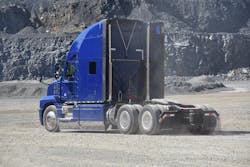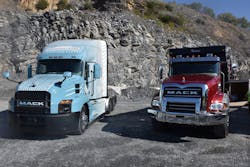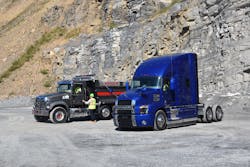EASTON, Pennsylvania—Driver-assistance technology can be a tough sell—it must be experienced to be fully understood. That's why Mack Trucks invited FleetOwner and other industry journalists to try out its Command Steer technology, a driver-assistance system designed to reduce driver fatigue.
What is Mack’s Command Steer?
That’s all a bit abstract, so what does it mean for the driver practically? The steering should feel lighter and rough roads should feel smoother to drive on. The steering-assist system should increase stability during high winds and on crowned roads. If the truck hits a pothole or has a blowout, it should remain on-course without veering out of control. Truckers who work in tight spaces, such as bulk haulers in fuel stations or grocery haulers in parking lots, should be able to make those sharp turns with more ease.
See also: Mack adds 'effortless' steering to driver assist toolbox
On Sept. 21, I got to try the technology for myself, driving four trucks—one Mack Anthem highway truck with Command Steer and one without, and one Mack Granite work truck with Command Steer and one without. I have no CDL. I have, however, driven Class 8s on a track before—but this was no track. This was a gravel pit 100 feet deep in the belly of a quarry. Cones were aligned along makeshift tracks, the winding dirt paths littered with dips and divots that were dug out by employees of H&K Group's Easton Quarry near Allentown, Pennsylvania, where Mack is headquartered. Less-than-ideal conditions for driving meant an ideal condition in which to test driver-assistance tech.
Testing the Mack Anthem’s Command Steer technology
The first pair of trucks I tested against the gauntlet was the Mack Anthem. This on-highway model typically would never be driven 10 stories below the earth, but the tractor without the Command Steer—the control variable, if you will—handled well enough as I bobtailed along, kicking up dust.
At least I thought it was handling well, but that was before I used the Command Steer as a frame of reference. Using the Anthem with the system made me realize how tensely I was having to grip the wheel to maintain control over ruts and rumble strips. The wheel felt lighter and more responsive, and the subtle self-correction against uneven terrain meant my hands were steady and I could keep my focus on the road instead of in the cab. Compared to the base model, I felt like I was gliding through the S-curves of the track.
See also: Western Star’s 57X: Safety tech put to the test
On my initial run sans Command Steer, I would let go of the wheel over the rumble strips and man-made potholes to watch it jerk back and forth as I kept my foot on the accelerator. When I did this with the Command Steer-equipped trucks, the wheel stayed almost still by comparison as the truck’s sensors kept us going forward on the path. Despite this, at no point did I feel like the truck was driving itself, or that I was having control wrested from me, or that I was having to fight the assistance system—quite the opposite. At all points, the truck felt more responsive, going more easily to where I wanted, it feeling more like a natural extension of myself.
If I let go of the wheel in the same manner in a truck with Command Steer, it will not noticeably drift to the left at all, the trucks sensors seemingly reading my mind and continuing on the path straight ahead. This is most useful when backing up into a tight space, which I expect any trucker would be doing almost daily. Adjusting my angle as I looked into the side mirrors was less stressful as I felt more in control of the truck.
The Command Steer’s ROI
In each of the four trucks I had a Mack representative coaching me and explaining the technology, and to each of those four passengers I asked the same question: If I was a manager buying trucks for my fleet, what would be the ROI on Command Steer? It’s an optional technology that must be installed during production and cannot be retrofitted—nor disabled by the driver. Mack representatives would not divulge how much Command Steer is to purchase, but it is an additional cost. How would this help my bottom line?
“It could be multiple ways. The No. 1 is what it’s going to do with driver retention,” said Tim Wrinkle, Mack’s senior product manager of vocational and medium-duty trucks. “Drivers will be fighting over being able to drive a truck with Command Steer.”
“It is one of those things you have to experience, so we’ve been encouraging our dealers to demo. It’s just a hard time because every truck on the lot, they’re selling, so it’s hard to keep a demo,” Wrinkle said, referencing ongoing supply chain shortages that are making it difficult for carriers to purchase new equipment.
See also: Topsy-turvy times for used trucks
The second thing that could help with the technology’s ROI, Wrinkle said, would be the increased safety it offers. Command Steer is designed to keep the truck on the road in the case of a blowout, preventing the truck pulling to the side and causing a rollover.
I cannot verify if every driver who has tried it is clamoring for the Command Steer system, but I can verify that the technology did make the vehicles easier to operate. I drove each truck in short 10-minute laps around the quarry, but I can imagine having a smoother control over the wheel over 10-hour days could increase driver comfort and ease driver fatigue to some degree. I also cannot tell all fleet managers whether they should or should not invest in Command Steer because I don’t know the needs of all fleets. What I can say is that, after approaching the technology with my usual healthy dose of journalistic skepticism, I wiped the dust from my jeans and walked away impressed. I would encourage anyone who receives an opportunity to try Command Steer to do so, because it’s a difference that needs to be felt to be truly understood.
About the Author
Scott Keith
Scott Keith is a former fleet owner digital editor, who was on staff from 2022 to 2023.




